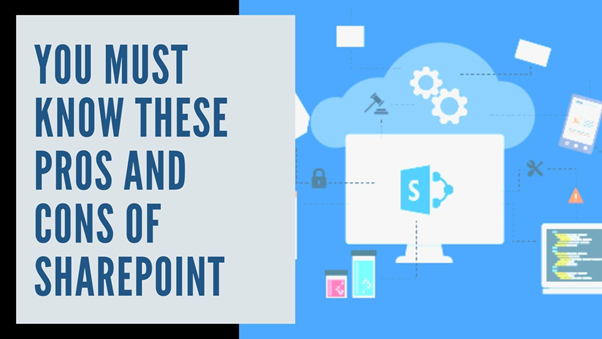You must know these Pros and Cons of SharePoint

Do you want to improve the productivity of your organization? Are you looking for a way to make communication easier at your firm?
You might want to take a closer look at the amazing benefits of the platform. This will help to make sure that you invest in the right platform.
Is it a good idea for your business to use SharePoint? Will you make a good decision?
We will give you features and benefits to help you make a decision.
What is SharePoint?
“Microsoft SharePoint Online is a web-based platform. It can be used with Microsoft Office for storing and sharing files. It’s a document management system.”
There is a secure workspace for organizations to coordinate and communicate in SharePoint. You can build tasks, track schedules, and get information about the projects.
The method to use SharePoint:
- Go to microsoft365.com as admin and choose the apps in the menu.
- Click on the page you want to create in the left-vertical pane.
- Go to the Team site.
- The design of your website will match your requirements.
- Correct details can be entered, which include name and description.
- Click on Finish to finish the setup
Why are SharePoint document libraries vital?
“They are used as a containing space for your members’ lists. It’s possible to have a separate library for every client, internal department and partner. The users have access to the documents once they click on the library.”
The best way to use the document library is by using this method.
- The documents can be selected in the left- vertical pane.
- To add new items, choose New. You can drag and drop files in the current library folder.
- The app will open a Microsoft Office file.
- Modern web apps allow you to modify the file with other people at the same time. You can still check out a file and stop others from working on it at the same time.
What is the purpose of SharePoint?
1. SharePoint Lists
You can manage the information using sharepoint lists and libraries. SharePoint lists are similar to spreadsheets that consist of rows and columns. It is available to users after concurrent access to avoid any hassle in the data.
The web-based features of the project management system make it easy to create, update, and review items in the list.
2. SharePoint Workflows
There is a set of decisions and tasks that give you the right outcomes. They are similar to the automated application that handles standard business processes. You can save time and effort by using a set of templates in SharePoint. Gaining consistency and efficiency for tasks will be helped by this.
There are different roles in the system.
- Creator: The person who will create the template of workflow.
- Author: The person who will configure the workflow of your organization using a workflow template.
- Initiator: This person will start a new workflow instance for a list item or document. They have permission to terminate the workflow if needed.
- Participant: This individual performs the task associated with the workflow
3. SharePoint Search
The basic feature allows users to enter and execute search queries. There is a scope of search in the recent website and any sub-sites. The application processes the query and returns results that match the queries.
Links to libraries, lists, sites, documents, or web pages may be included in the search results. Permissions, previous searches, and the context in responding to your queries are needed by the search engine. If you add words to the search query box, it will return the solutions.
4. SharePoint Libraries
“The host can use it to store, group, modify, filter, and capture vital data. The library can be used to store the data’s contents.”
A library allows the members to manage, create, collect, and update files collaboratively. One of the many benefits of SharePoint is that you also get access to a great number of default libraries for specific purposes. You get the freedom to use default library apps to build new libraries.
5. SharePoint Project Site
The template has components that support project management.
- There is a project summary.
- The timetable for the task.
- The task list.
- There is a calendar
- It has a document library.
- There are features in task management.
“It’s convenient to handle tasks and projects hassle-free using this method.”
What are the pros and cons of SharePoint?
Pros of SharePoint
- Many Features: It has a diverse set of features like task management, document management, security information, and asset library. This gives your organization a seamless experience in sharing, managing, and storing information in the digital world.
- Office 365 Integration: Office 365 products work seamlessly with SharePoint. Your organization can leverage all products and connect them with SharePoint.
- Integration: There are great exclusive functionalities with SharePoint. You can also integrate extensions with existing businesses, including CRM and ERM. This will make it easier for organizations to get access to information.
- Customization: Many organizations are choosing SharePoint as it can be molded to meet various business requirements. It gives you different types of enterprise solutions, intranets, portals, collaborative workspaces, and more.
- Reliability: With Microsoft support, you can rely upon solutions during setup, installation, and more. They will provide answers to the technical problems you come across in SharePoint.
- Collaboration: SharePoint aims to increase employee participation if used properly. You can use it as a central hub for messages, video chat, schedule meetings, and other productivity tools.
- Data Security: Microsoft SharePoint online has advanced level protection. The data transmissions are protected using the best encryption method. There is two-factor authentication to identify the correct users.
Cons of SharePoint
- Less Control: Once you move to cloud services, you get control of the front-end and could disrupt your business requirements.
- Increases Bandwidth: It is a slow and painful experience after migrating with Office 365 and may increase your bandwidth.
- Extra Development Efforts: Consider the additional time, issues, and cost required in case of integration. This might affect the productivity of the employees.
- Extensive Features are complicated: With a wide range of SharePoint features and benefits, you get confused. It consumes more time to invest in tailoring the perfect features and functions.
The Last Takeaway!
“The features, pros, and cons of SharePoint have been provided by us. It’s perfect for small, medium and large businesses that need team collaboration.”




